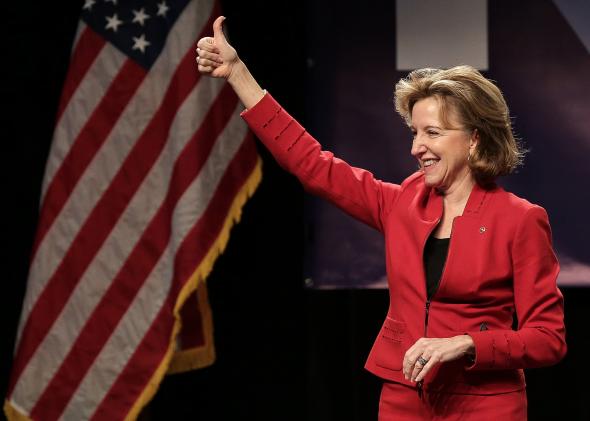Peak Negativity
We are about to reach 1 million U.S. Senate race ads. Few had anything nice to say.

Photo by Win McNamee/Getty Images
After this year’s U.S. Senate races are run and done, the notoriously nasty contests will likely limp into history with this distinction: Candidates, political groups, and nonprofits will have combined to air more than 1 million television ads.
Through Monday, about 908,000 U.S. Senate–focused TV ads have aired this election cycle, according to a Center for Public Integrity review of preliminary data provided by Kantar Media/CMAG, an advertising tracking firm. With a week’s worth of advertising yet to be tallied, to say nothing of the deluge of messaging that would flood anticipated runoff contests in Georgia and Louisiana, the million-ad mark will be eclipsed soon.
Last week alone, candidates, party committees, super PACs, nonprofit groups, and others together produced 83,000 U.S. Senate–focused ads—more than any other single week during the 2014 election cycle. The Democratic Senatorial Campaign Committee, National Republican Senatorial Committee, and pro-Democrat super PAC Senate Majority PAC were tops among about 110 U.S. Senate-related ad sponsors. Most of the ads contained highly negative content, as Republicans are fighting to capture six seats needed to win control of the U.S. Senate.
North Carolina’s race between Democratic incumbent Sen. Kay Hagan and Thom Tillis, her Republican rival, drew more ads last week than any other contest—about 11,000 from Oct. 21 through Monday. That’s more than one ad per minute, on average.
Meanwhile, in Iowa, where Democratic Rep. Bruce Braley and GOP state Sen. Joni Ernst are battling for an open seat in the wake of Democratic Sen. Tom Harkin’s retirement, voters saw about one U.S. Senate–focused ad a minute. And in both Colorado and Georgia, voters were subjected to about two TV ads every three minutes, according to the Center for Public Integrity’s analysis of estimates provided by Kantar Media/CMAG. U.S. Senate races in Louisiana, Kansas, Kentucky, and Arkansas all saw about one TV ad every two minutes last week.
That illustrates a massive change in the dynamics of Kansas’ race. During the week after Labor Day, for example, Kansas TV viewers only saw, on average, one U.S. Senate–focused ad every 22 minutes. In Kansas, Republican Sen. Pat Roberts is being challenged by independently wealthy independent Greg Orman—the Democratic candidate dropped out of the race in early September—and the state’s U.S. Senate race has unexpectedly turned into a dead heat.
Conversely, in Michigan, TV viewers have recently received more of a reprieve. There, Democratic Rep. Gary Peters is running against Republican Terri Lynn Land for the seat being vacated by retiring Democratic Sen. Carl Levin. In early and mid-September, Michigan’s U.S. Senate race ranked among the hottest in the country, attracting nearly one TV ad every two minutes at its height. But last week, the contest saw only about 1,700 TV ads—about one spot every six minutes. Twelve other U.S. Senate races drew more ads last week. Recent polls have shown Peters with a solid lead, which may largely explain the TV ad decline.
While the tone of last week’s U.S. Senate ads remain, on balance, overwhelmingly negative, a few of the most spite-filled states found themselves filled with slightly less bane. Notable among them: North Carolina, the most negative U.S. Senate race in the nation for mid-October.
The week before last, the Tar Heel State played host to more than 10,800 U.S. Senate–focused ads—and all but two-dozen of them contained at least some negative content, attacking either Hagan or Tillis. But last week, about 530 of North Carolina’s more than 11,000 U.S. Senate–focused TV ads—roughly 5 percent—curbed the negativity for messages that strictly promoted one of the candidates.
So, how ugly is North Carolina’s political discourse these days?
Ugly enough that an exasperated child at Vance Elementary School in Raleigh, North Carolina, wrote a letter to Hagan and Tillis asking them, in the name of respect and civility, to chill the heck out.
“All I hear in your ads are you saying mean things about each other,” student Carson Park wrote. “Will you act like this after the election? Seeing the ads on TV makes me sad and I don’t want to vote.”
But one class of people—broadcasters—is enjoying the advertising boom.
KUSA-TV 9 in Denver, where more than 900 U.S. Senate–related ads ran last week, attracted more than any other station in the country. It’s followed by KMGH-TV in Denver; WHO-TV 13 in Des Moines, Iowa; WSOC-TV 9 in Charlotte, North Carolina; KAKE-TV 10 in Wichita, Kansas; and KSNW-TV 3 also in Wichita, according to the analysis of Kantar Media/CMAG data.
For the first time in three weeks, WMUR-TV 9 in New Hampshire, where Democratic Sen. Jeanne Shaheen is locked in a close race against Republican Scott Brown, didn’t air the most U.S. Senate–related TV ads during a one-week period.
This story was published by the Center for Public Integrity, a nonprofit, nonpartisan investigative news organization in Washington, D.C.